Carlow, Co. Carlow
Carlow Poor Law Union was formally declared on the 15th September 1840 and covered an area of 280 square miles. Its operation was overseen by an elected Board of Guardians, 30 in number, representing its 14 electoral divisions as listed below (figures in brackets indicate numbers of Guardians if more than one):
Co. Carlow:
Bagenalstown (2), Barragh (2), Borris (2), Carlow (4), Fennagh and Nurney (2), Grangeford, Idrone West (3), Kellistown, Kiltennell (2), Myshall (2), Tullow (2).
Queen's County:
Arless (2), Graigue (3), Shrule (2).
Later additions:
Agha, Ardough, Ballickmoyler, Ballinacarrig, Ballintemple, Ballon, Ballyellin, Ballylehane, Ballymoon, Burtonhall, Clogrenan, Clonegal, Corries, Cranemore, Doonane, Farnans, Garryhill, Johnstown, Kilbride, Killedmond, Killerigg, Leighlinbridge, Newtown, Nurney, Old Leighlin, Rathanne, Rathornan, Rathrush, Ridge, Rossmore, Shangarry, Sliguff, Tankardstown, Templepeter, Tullowbeg, Turra.
The Board also included 10 ex-officio Guardians, making a total of 40. The Guardians met each week on Thursday.
The population falling within the Union at the 1831 census had been 74,727 with divisions ranging in size from Grangeford (population 3,227) to Carlow itself (11,318).
The new Carlow Union workhouse was erected in 1842-4 on a 7.5-acre site ¾ of a mile to the south of Carlow. Designed by the Poor Law Commissioners' architect George Wilkinson, the building was designed to accommodate 800 inmates. Its construction cost £9,000 plus £1,470 for fittings etc. The site location and layout are shown on the 1908 OS map below.
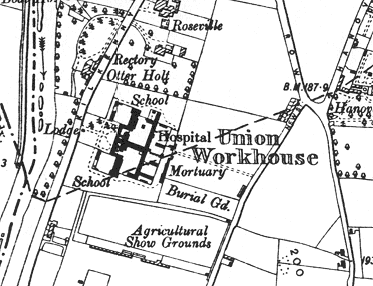
Carlow workhouse site, 1908.
The workhouse was declared fit for the reception of paupers on 16th September 1844, and received its first admissions on 18th November.
During the famine in the mid-1840s, sheds were erected to accommodate an additional 160 inmates. A building was hired as a temporary fever hospital accommodating 70 patients.
Wilkinson's proposed design for the workhouse is shown below. Male accommodation lay at the north of the site and female to at the south. Single storey probationary wards lay to each side of the entrance at the west. the three-storey central portion of the main building probably contained administrative offices, the Master's quarters and Guardians' board room. The wings to each side contained inmates accommodation with children's quarters and school rooms at each end. Kitchens and washhouse lay to the rear, leading to a central spine containing the chapel and dining-hall. Infirmary and idiot wards stood at the east, each with its own yard.
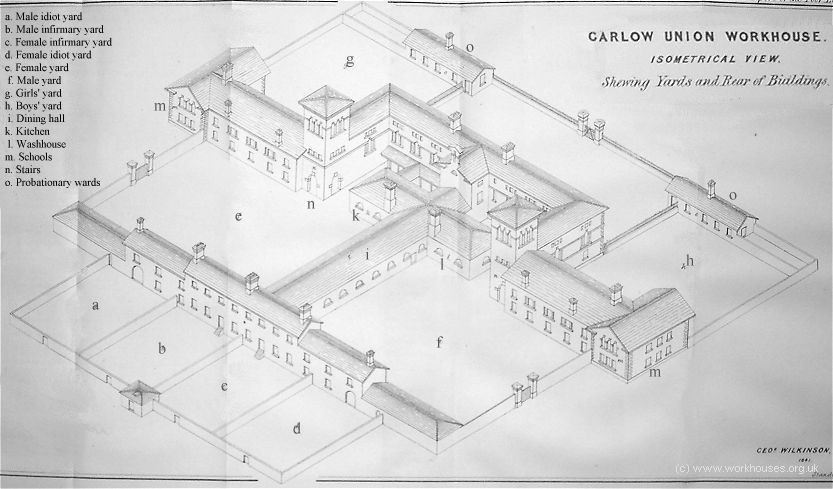
Carlow workhouse plan from the north-east
© Peter Higginbotham.

Carlow workhouse proposed design from the south-west
© Peter Higginbotham.
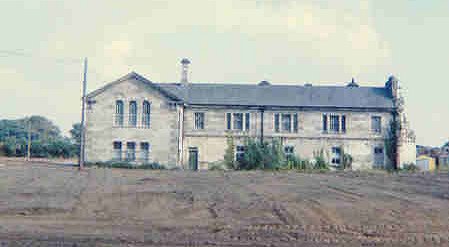
Carlow northern school wing from the west.
© Carloman.
A mortuary lay at the rear, with the workhouse's burial ground at the south-east of the site. The map also shows a small lodge stood at the entrance to the site at the west.
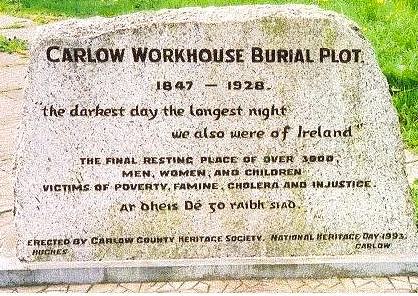
Carlow workhouse graveyard memorial.
© Carloman.
Although Wilkinson's design had many elements in common with his other Irish workhouses, the long main block with its swept-back arcaded wings was unique to Carlow and resulted from demands by the Guardians for a building that was in keeping with the style of others in the area. The arched walkways along the front of the building's wings does not appear on surviving photographs but they may have been removed at some point in the building's history. A similar feature can be seen at the St Asaph workhouse in north Wales.
In 1921, the Free State Army commandeered the workhouse buildings, with the existing inmates being removed to the town's Old Barracks which the Army were vacating. The Barracks — a three-storey building with stables on the ground floor — were then fiited out as a County Home.
The Carlow workhouse buildings no longer exist and a college now stands on the site.
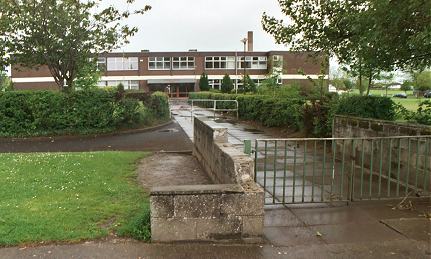
Carlow former workhouse site from the west, 2002
© Peter Higginbotham.
Records
Note: many repositories impose a closure period of up to 100 years for records identifying individuals. Before travelling a long distance, always check that the records you want to consult will be available.
- Carlow County Library, Tullow Street, Carlow. Holdings: Guardians' minute books (1845-1923).
Bibliography
- Foley, P (1999) The Carlow Workhouse by Patrick Foley (in Carloviana, 47, December 1999)
- Crossman, V (2006) Politics, Pauperism and Power in Late Nineteenth-century Ireland
- Gould, Michael H (1983) The Workhouses of Ulster
- Gray, P (2009) The Making of the Irish Poor Law, 1815-43
- O'Connor, J (1995) The Workhouses of Ireland
Links
Unless otherwise indicated, this page () is copyright Peter Higginbotham. Contents may not be reproduced without permission.


